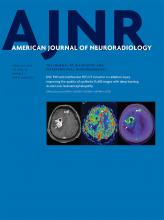Index by author
Tabar, V.
- FunctionalOpen AccessResting-State Functional Connectivity of the Middle Frontal Gyrus Can Predict Language Lateralization in Patients with Brain TumorsS. Gohel, M.E. Laino, G. Rajeev-Kumar, M. Jenabi, K. Peck, V. Hatzoglou, V. Tabar, A.I. Holodny and B. VachhaAmerican Journal of Neuroradiology February 2019, 40 (2) 319-325; DOI: https://doi.org/10.3174/ajnr.A5932
Tachibana, Y.
- EDITOR'S CHOICEAdult BrainOpen AccessImproving the Quality of Synthetic FLAIR Images with Deep Learning Using a Conditional Generative Adversarial Network for Pixel-by-Pixel Image TranslationA. Hagiwara, Y. Otsuka, M. Hori, Y. Tachibana, K. Yokoyama, S. Fujita, C. Andica, K. Kamagata, R. Irie, S. Koshino, T. Maekawa, L. Chougar, A. Wada, M.Y. Takemura, N. Hattori and S. AokiAmerican Journal of Neuroradiology February 2019, 40 (2) 224-230; DOI: https://doi.org/10.3174/ajnr.A5927
Forty patients with MS were prospectively included and scanned (3T) to acquire synthetic MR imaging and conventional FLAIR images. Synthetic FLAIR images were created with the SyMRI software. Acquired data were divided into 30 training and 10 test datasets. A conditional generative adversarial network was trained to generate improved FLAIR images from raw synthetic MR imaging data using conventional FLAIR images as targets. The peak signal-to-noise ratio, normalized root mean square error, and the Dice index of MS lesion maps were calculated for synthetic and deep learning FLAIR images against conventional FLAIR images, respectively. Lesion conspicuity and the existence of artifacts were visually assessed. The peak signal-to-noise ratio and normalized root mean square error were significantly higher and lower, respectively, in generated-versus-synthetic FLAIR images in aggregate intracranial tissues and all tissue segments. The Dice index of lesion maps and visual lesion conspicuity were comparable between generated and synthetic FLAIR images. Using deep learning, the authors conclude that they improved the synthetic FLAIR image quality by generating FLAIR images that have contrast closer to that of conventional FLAIR images and fewer granular and swelling artifacts, while preserving the lesion contrast.
Takemura, M.Y.
- EDITOR'S CHOICEAdult BrainOpen AccessImproving the Quality of Synthetic FLAIR Images with Deep Learning Using a Conditional Generative Adversarial Network for Pixel-by-Pixel Image TranslationA. Hagiwara, Y. Otsuka, M. Hori, Y. Tachibana, K. Yokoyama, S. Fujita, C. Andica, K. Kamagata, R. Irie, S. Koshino, T. Maekawa, L. Chougar, A. Wada, M.Y. Takemura, N. Hattori and S. AokiAmerican Journal of Neuroradiology February 2019, 40 (2) 224-230; DOI: https://doi.org/10.3174/ajnr.A5927
Forty patients with MS were prospectively included and scanned (3T) to acquire synthetic MR imaging and conventional FLAIR images. Synthetic FLAIR images were created with the SyMRI software. Acquired data were divided into 30 training and 10 test datasets. A conditional generative adversarial network was trained to generate improved FLAIR images from raw synthetic MR imaging data using conventional FLAIR images as targets. The peak signal-to-noise ratio, normalized root mean square error, and the Dice index of MS lesion maps were calculated for synthetic and deep learning FLAIR images against conventional FLAIR images, respectively. Lesion conspicuity and the existence of artifacts were visually assessed. The peak signal-to-noise ratio and normalized root mean square error were significantly higher and lower, respectively, in generated-versus-synthetic FLAIR images in aggregate intracranial tissues and all tissue segments. The Dice index of lesion maps and visual lesion conspicuity were comparable between generated and synthetic FLAIR images. Using deep learning, the authors conclude that they improved the synthetic FLAIR image quality by generating FLAIR images that have contrast closer to that of conventional FLAIR images and fewer granular and swelling artifacts, while preserving the lesion contrast.
Tan, Z.
- Adult BrainYou have accessAlterations in Brain Metabolites in Patients with Epilepsy with Impaired Consciousness: A Case-Control Study of Interictal Multivoxel 1H-MRS FindingsZ. Tan, X. Long, F. Tian, L. Huang, F. Xie and S. LiAmerican Journal of Neuroradiology February 2019, 40 (2) 245-252; DOI: https://doi.org/10.3174/ajnr.A5944
Thomas, A.J.
- InterventionalYou have accessEndothelialization following Flow Diversion for Intracranial Aneurysms: A Systematic ReviewK. Ravindran, M.M. Salem, A.Y. Alturki, A.J. Thomas, C.S. Ogilvy and J.M. MooreAmerican Journal of Neuroradiology February 2019, 40 (2) 295-301; DOI: https://doi.org/10.3174/ajnr.A5955
Tian, F.
- Adult BrainYou have accessAlterations in Brain Metabolites in Patients with Epilepsy with Impaired Consciousness: A Case-Control Study of Interictal Multivoxel 1H-MRS FindingsZ. Tan, X. Long, F. Tian, L. Huang, F. Xie and S. LiAmerican Journal of Neuroradiology February 2019, 40 (2) 245-252; DOI: https://doi.org/10.3174/ajnr.A5944
Tiemeier, H.
- PediatricsOpen AccessCavum Septum Pellucidum in the General Pediatric Population and Its Relation to Surrounding Brain Structure Volumes, Cognitive Function, and Emotional or Behavioral ProblemsM.H.G. Dremmen, R.H. Bouhuis, L.M.E. Blanken, R.L. Muetzel, M.W. Vernooij, H.E. Marroun, V.W.V. Jaddoe, F.C. Verhulst, H. Tiemeier and T. WhiteAmerican Journal of Neuroradiology February 2019, 40 (2) 340-346; DOI: https://doi.org/10.3174/ajnr.A5939
Tomasian, A.
- InterventionalYou have accessPercutaneous CT-Guided Skull Biopsy: Feasibility, Safety, and Diagnostic YieldA. Tomasian, T.J. Hillen and J.W. JenningsAmerican Journal of Neuroradiology February 2019, 40 (2) 309-312; DOI: https://doi.org/10.3174/ajnr.A5949
Triulzi, F.M.
- PediatricsYou have accessBrain DSC MR Perfusion in Children: A Clinical Feasibility Study Using Different Technical Standards of Contrast AdministrationS. Gaudino, M. Martucci, A. Botto, E. Ruberto, E. Leone, A. Infante, A. Ramaglia, M. Caldarelli, P. Frassanito, F.M. Triulzi and C. ColosimoAmerican Journal of Neuroradiology February 2019, 40 (2) 359-365; DOI: https://doi.org/10.3174/ajnr.A5954
Tsang, A.C.O.
- SpineYou have accessSingle-Needle Lateral Sacroplasty TechniqueP.J. Nicholson, C.A. Hilditch, W. Brinjikji, A.C.O. Tsang and R. SmithAmerican Journal of Neuroradiology February 2019, 40 (2) 382-385; DOI: https://doi.org/10.3174/ajnr.A5884








